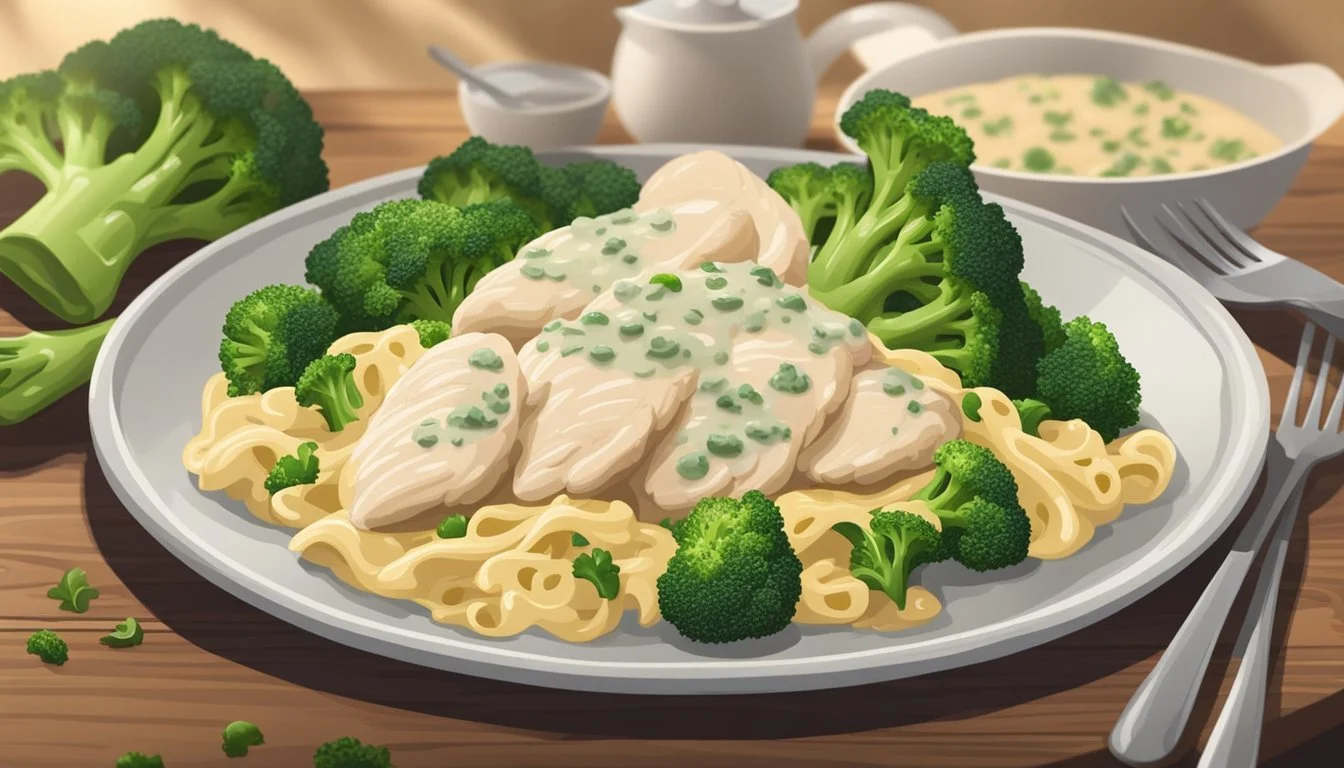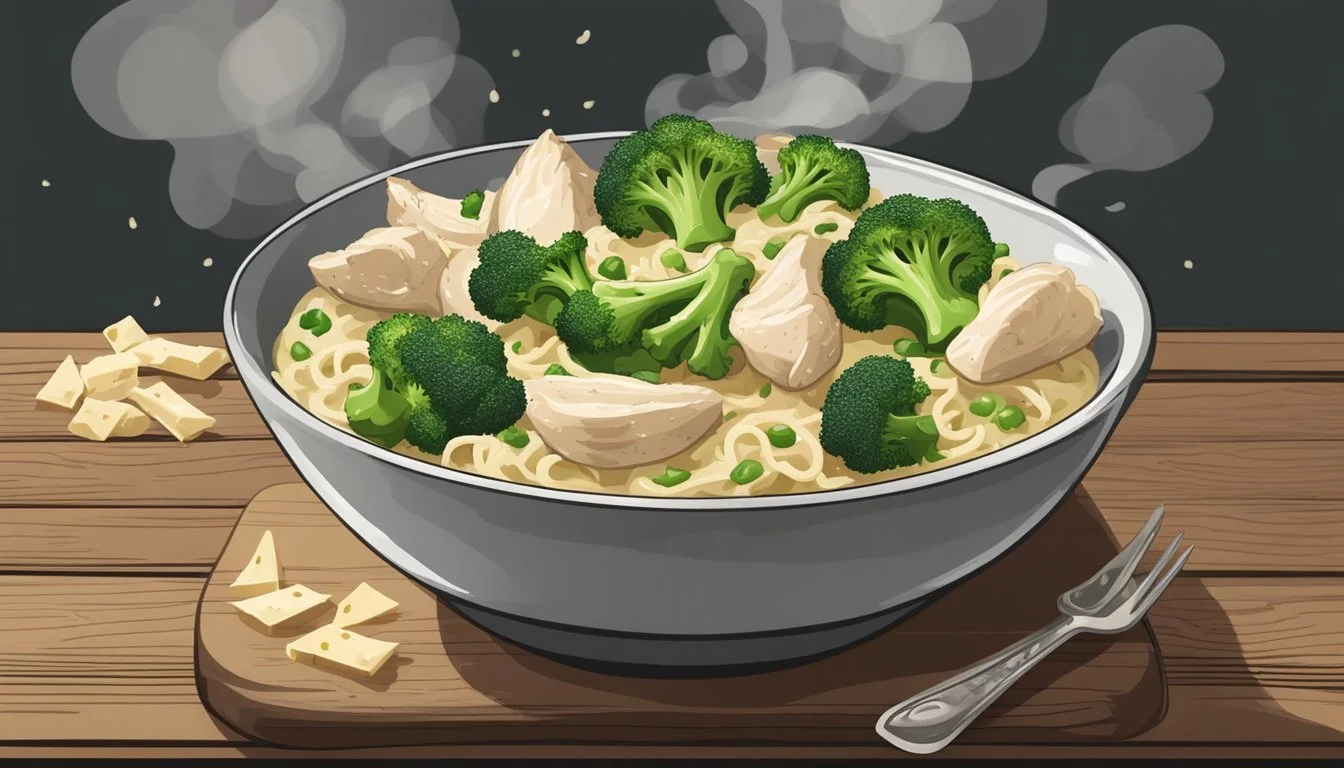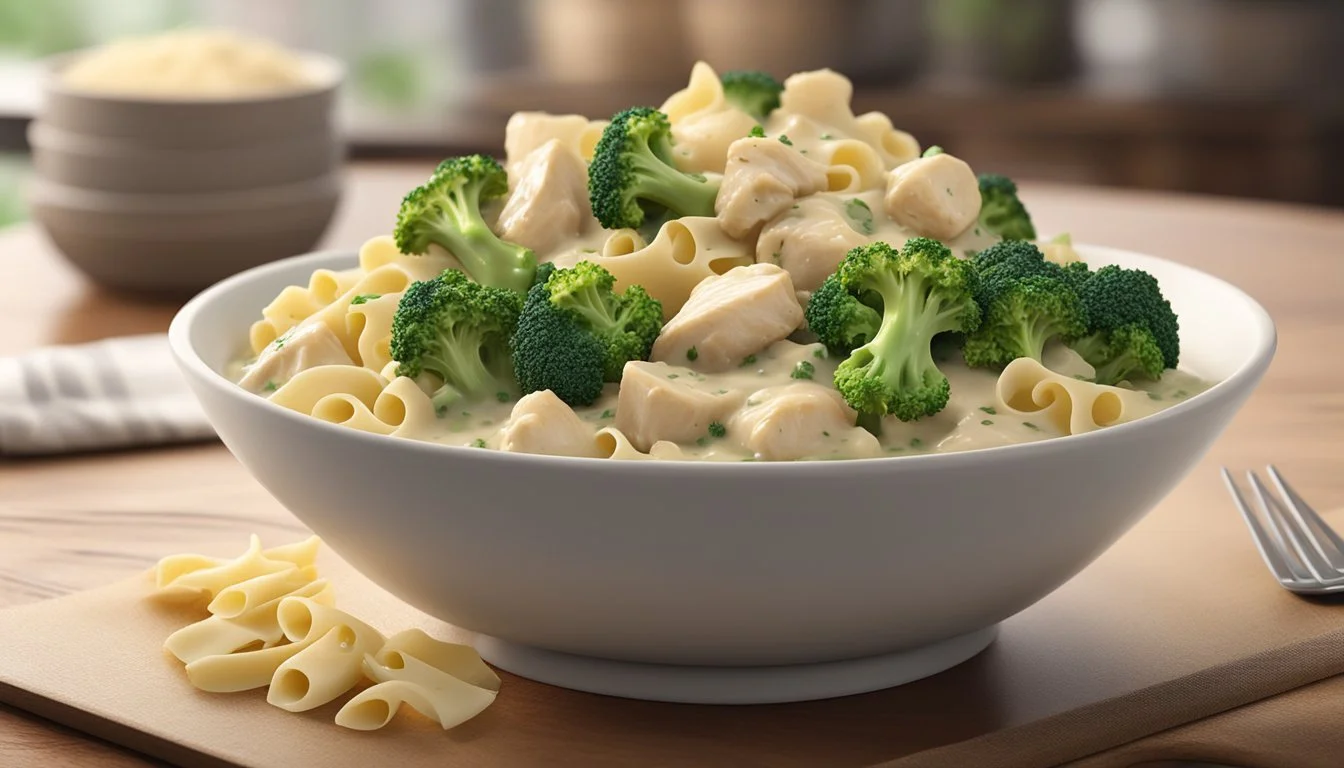Best Way to Reheat Chicken and Broccoli Alfredo
Ensuring Creamy and Crunchy Leftovers
Reheating Chicken and Broccoli Alfredo presents a unique challenge: to preserve its rich and creamy sauce while maintaining the tender texture of the chicken and the slight crunch of the broccoli. The best reheating method hinges on a balance of temperature and technique to achieve a dish that seems as freshly made as possible. Attention to detail can make the difference between a satisfying meal and a disappointing one.
An oven-based strategy for reheating Chicken and Broccoli Alfredo is most effective for achieving uniform warmth without sacrificing texture. The gradual heating process allows the dish to reach the optimal temperature, ensuring that the chicken remains juicy and the broccoli retains its crunch. The addition of a little moisture before heating can combat the dryness often associated with leftovers, helping to revive the creamy consistency of the alfredo sauce.
When using a microwave, care must be taken to avoid overheating, which can quickly lead to unevenly warmed components and a compromised dish. Stirring at intervals and adding a touch of liquid, such as milk or cream, can assist in restoring the alfredo's smooth texture. Each of these methods, when executed with precision, allows the Chicken and Broccoli Alfredo to be enjoyed with its intended flavors and textures intact.
Understanding the Components of Chicken and Broccoli Alfredo
Reheating Chicken and Broccoli Alfredo effectively to maintain its creaminess and crunch requires an understanding of the dish’s core components, from the rich Alfredo sauce to the perfectly cooked pasta.
Creaminess of Alfredo Sauce
The Alfredo sauce's signature creaminess comes from rich ingredients such as heavy cream, butter, and Parmesan cheese. When reheating, it's crucial to restore this creaminess without causing separation, which often occurs when dairy-based sauces are overheated or heated too quickly.
Texture of Chicken and Broccoli
Chicken is a lean protein that maintains its moisture when reheated properly, while broccoli, a crunchy vegetable, should retain its vibrant color and slight crispness. Overheating can make chicken tough and dry broccoli out, losing their ideal textures.
Storing Chicken Alfredo
Leftover Chicken Alfredo should be stored in an airtight container in the refrigerator. To prevent spoilage, cool leftovers quickly and refrigerate within two hours of cooking. Proper storage extends shelf life and preserves the dish’s quality for future reheating.
Safety and Food Spoilage
Safety is paramount when dealing with leftovers. Store Chicken and Broccoli Alfredo at a temperature below 40°F to prevent bacterial growth. Reheat to an internal temperature of 165°F to ensure it's safe to eat. Discard any leftovers that show signs of spoilage or have been stored longer than the recommended 3-4 days.
Pasta and Its Tendency to Dry Out
Pasta, especially fettuccine, which is commonly used in Alfredo dishes, has a tendency to dry out when refrigerated. Moisture is key to maintain texture during reheating. Adding a small amount of milk or water can help reintroduce moisture to the dish.
Importance of Even Heating
Even distribution of heat is essential to revive the dish without drying it out. Methods like the double boiler, stovetop, and oven can provide more control and evenly distribute heat compared to the quick but often uneven microwave method.
Preparation for Reheating
Proper preparation ensures that Chicken and Broccoli Alfredo retains its creaminess and crunch when reheated. The reader should pay attention to the three key stages in the preparation process: bringing the dish to room temperature, preheating the oven, and arranging the Alfredo for optimal reheating results.
Bringing to Room Temperature
Before reheating, it is crucial for the Chicken and Broccoli Alfredo to sit out of the refrigerator to reach room temperature. This step creates a more even heating process since the temperature from the fridge can cause longer reheating times and may result in unevenly warmed elements.
Preheating the Oven
A vital step before the actual reheating is to preheat the oven to 350°F (175°C). This ensures the dish is cooked through at a controlled heat, preventing the sauce from separating and the broccoli from losing its crunch.
Arranging the Dish for Reheating
The Alfredo should be transferred into an oven-safe dish if it isn't in one already. Cover the dish with aluminum foil, which helps to retain moisture and prevent the Alfredo from drying out. Ensure the baking dish allows for space around the food for proper heat circulation.
Reheating Techniques and Best Practices
To ensure that Chicken and Broccoli Alfredo is reheated to perfection, retaining its creaminess and the broccoli's crunch, it's crucial to choose the right reheating method. Each technique offers a unique approach to achieve the desired temperature and texture without sacrificing the dish's quality.
Oven Reheating Method
The oven method provides slow heating that's ideal for keeping the Alfredo sauce creamy. One should:
Preheat the oven to 350°F (175°C).
Use an oven-safe dish and cover the Chicken and Broccoli Alfredo with aluminum foil to prevent drying out.
Heat for 10-15 minutes, checking occasionally, until it reaches the desired temperature.
Stovetop Reheating Method
Reheating on the stovetop allows for better control, using low to medium heat to gently warm the dish while stirring:
Place the Alfredo in a saucepan over medium heat.
Add a splash of milk or cream and stir frequently.
Allow the sauce to simmer without coming to a boil to maintain the sauce's creaminess and prevent the broccoli from losing its crunch.
Microwave Reheating Method
Microwaving is quick and convenient. One should use the following steps for even heating:
Place the dish in a microwave-safe container and cover with microwave-safe plastic wrap or a lid to trap steam.
Heat on medium power in 1-minute intervals, stirring between each, until hot.
Double Boiler Reheating Method
A double boiler applies gentle heat and is recommended for dishes with delicate sauces like Alfredo:
Fill the bottom pot of the double boiler with water and bring to a simmer over low heat.
Place the Chicken and Broccoli Alfredo in the top pan and heat.
Frequently stir to maintain even heat distribution and creaminess.
Additional Tips and Serving Suggestions
Proper reheating techniques can make a significant difference in enjoying leftover Chicken and Broccoli Alfredo. This section provides targeted advice to preserve its texture and taste, ensuring that one can relish the dish as if it was freshly made.
Adding Moisture and Flavor
To maintain the creaminess of the Alfredo sauce, one may add a small amount of water or chicken broth before reheating. A gentle heat allows flavors to meld without reducing moisture. For added richness, a pat of butter can be stirred in just before serving, and fresh herbs like parsley enhance the dish's aroma and taste.
Preventing Separation and Curdling
Alfredo sauce may separate or curdle if reheated too quickly or at too high a temperature. Heating over a low temperature, while continuously stirring, helps keep the sauce smooth. In a saucepan, simmer the pasta on gentle heat, occasionally stirring to prevent the sauce from breaking and to ensure even warming throughout.
Serving and Pairing
Once the Chicken and Broccoli Alfredo is thoroughly warmed, it should be served immediately to preserve its appealing texture. The pasta can be complemented with a side of crisp salad or warm garlic bread. For a final touch, sprinkle freshly grated Parmesan cheese and parsley over the pasta to enhance its visual appeal and flavor.
Storing and Future Uses
Leftover Chicken and Broccoli Alfredo should be stored in an airtight container and refrigerated to extend its shelf life. It is best consumed within two days. For longer storage, portions can be freeze; however, upon defrosting, the sauce's texture may change. When reheating frozen leftovers, a gradual defrost in the refrigerator followed by a careful reheat is recommended to best preserve the dish's quality.
Troubleshooting Common Reheating Issues
Perfectly reheating Chicken and Broccoli Alfredo ensures the dish maintains its creaminess while preventing the pasta from overcooking and the sauce from separating. This section provides specific solutions to common reheating challenges.
Dealing with Overcooked Pasta
When reheating fettuccine alfredo, the pasta can easily become mushy. To avoid this, reheat gently. If using a microwave, heat in short bursts and check frequently. In a stovetop situation, quickly toss the pasta in the sauce to heat through, avoiding prolonged cooking.
Handling Separation of Sauce
Alfredo sauce can separate or curdle due to the cheese and heavy cream content. To prevent this, one should stir frequently while reheating, and use a low heat setting. Adding a small amount of cream can help reincorporate the separated sauce and restore its smooth texture.
Retaining the Creaminess
The key to retaining creaminess in Alfredo sauce is to avoid high heat. Reheat on low heat and add a splash of milk or cream to the sauce. Stir continuously to ensure that the cheese and cream do not separate, keeping the sauce rich and creamy.
Maintaining Proper Texture of Chicken and Broccoli
Chicken and broccoli should retain their texture – the protein should stay juicy and the vegetables should keep their crunch. Reheat these elements separately from the pasta and sauce if possible. Steam broccoli briefly to maintain crunch, and gently heat chicken covered, to prevent it from drying out.
Conclusion
When reheating chicken alfredo, especially when it includes broccoli, the key is to retain the dish's inherent creaminess while ensuring that the broccoli remains crisp. Here's a concise, step-by-step method to achieve that:
Preheat your oven to 350°F (175°C).
In an oven-safe dish, evenly spread the leftover chicken alfredo to promote uniform heating.
To maintain moisture, lightly drizzle with milk or cream.
Cover with aluminum foil to keep the moisture in and prevent the top from drying.
Warm the dish in the oven for 20-30 minutes. If the chicken alfredo was frozen, heat for up to 60 minutes, checking regularly.
Once adequately heated, stir gently to distribute the heat throughout the sauce.
If time is a constraint, microwaving is an alternative, though one must be cautious to stir frequently and add moisture as necessary.
It's recommended to serve the reheated chicken alfredo immediately to enjoy its flavor and texture optimally. Remember, every leftover is a chance to revisit a favorite meal, and the effort put into preserving its quality reflects one’s culinary diligence.
By following these steps, diners can indulge in their chicken and broccoli alfredo, reliving the original experience of their favorite pasta dish. With care and the right technique, leftovers need not feel like a compromise.
Frequently Asked Questions
When reheating chicken and broccoli Alfredo, maintaining the dish's creamy sauce and the broccoli's desired crunch is paramount. This section will address common concerns on how to avoid dryness and select the proper container for reheating.
Best Ways to Prevent Dryness
Reheating chicken and broccoli Alfredo requires special attention to preserving moisture without making the dish soggy. Here are key steps to avoid dryness:
Add liquid: If the Alfredo sauce seems thick, gently stir in a small amount of milk or water before reheating to bring back creaminess.
Cover the dish: Use aluminum foil or a lid when reheating in an oven to trap steam and maintain moisture.
Using a low temperature setting is also crucial. Heating at 350°F (175°C) allows for a gentle warm-up, thus preventing the sauce from separating and the broccoli from overcooking.
Recommended Containers for Reheating
The choice of container when reheating chicken and broccoli Alfredo can greatly affect the outcome.
For ovens: An oven-safe dish, preferably ceramic or glass, is recommended. It should be covered with aluminum foil to retain moisture.
For microwaves: A microwave-safe dish is suitable. One can cover the dish with a microwave-safe lid or plastic wrap, making sure to leave a corner open to allow steam to escape.
When opting to reheat in a microwave, stir the Alfredo periodically to ensure even heating. In the oven, one might need to stir once halfway through.
Pairing and Side Dishes
When reheating Chicken and Broccoli Alfredo, it's essential to complement the meal with sides that will balance the creaminess of the sauce and maintain the dish's textural integrity.
Salad Options
A salad offers a refreshing contrast to the rich Alfredo sauce. Here are some recommendations:
Garden Salad: This should include a mix of fresh vegetables such as lettuce, cucumbers, and cherry tomatoes. Dress it lightly with an Italian or balsamic vinaigrette to avoid overpowering the Alfredo's flavor.
Caesar Salad: For a classic pairing, this should contain crisp romaine lettuce, a sprinkle of Parmesan cheese, and crunchy croutons tossed in Caesar dressing. The garlicky and tangy flavors in the dressing complement the chicken and broccoli nicely.
Bread Varieties for a Complete Meal
Introducing bread to this meal adds a hearty dimension that can round out the dining experience. Options include:
Garlic Bread: It should be slathered with a mix of butter, minced garlic, and a touch of fresh parsley, then baked until golden. The robust flavor of garlic bread pairs well with the creamy Alfredo.
Herbed Dinner Rolls: They should be soft and brushed with a mix of melted butter and finely chopped fresh herbs like rosemary or thyme to add a fragrant touch that echoes the herbs in the Alfredo sauce.
Final Thoughts
Reheating Chicken and Broccoli Alfredo requires attention to detail to ensure that the dish's creaminess and the broccoli's crunch are preserved. Experts advise a slow reheating process to retain the dish’s integrity.
For oven reheating, users should:
Preheat the oven to 350°F (175°C).
Place the Alfredo in an oven-safe dish, adding a bit of milk to maintain creaminess.
Cover the dish with foil to lock in moisture.
Heat for 15-20 minutes if refrigerated; check and stir occasionally.
When using a stovetop, chefs recommend:
Using a saucepan over medium heat.
Stirring constantly for even heat distribution.
Adding milk or cream as needed to achieve the desired consistency.
Being careful to avoid boiling the sauce.
One should:
Serve immediately after reheating to enjoy the dish's optimal taste and texture.
Reheat only the portion to be consumed to maintain freshness.
They can feel confident in their ability to successfully reheat Chicken and Broccoli Alfredo by following these methods. These instructions are crafted by knowledgeable sources, aiming to help users make the most out of their leftovers while maintaining quality.







